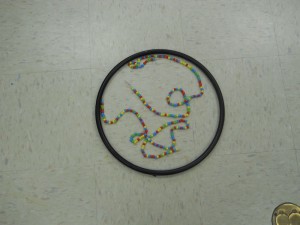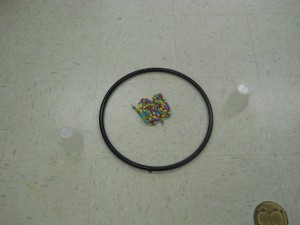Now that we have an idea of what a strand of DNA looks like we’re going to start talking about how our genes are passed on to our kids.
During normal time (interphase) our DNA is stored in the nucleus of our cells. Humans have 23 pairs of chromosomes. Of each pair, one comes from your mom and one from your dad.

When a cell is not reproducing (which is most of the time) the chromosomes are unspooled threads in the cell’s nucleus.

When the cell is preparing to reproduce, each DNA strand duplicates.

Then they fold up into the chromosomes and line up in the center of the cell.

Now this is where interesting things start to happen. In mitosis, each chromosome pairs up with its duplicate, so when these are pulled apart you get two new cells with exactly the same DNA.

In meiosis however, where the cell breaks apart into reproductive cells called gametes, the two parent chromosomes pair up and exchange some DNA before being pulled apart (the DNA exchange is called crossing over). Since the DNA has duplicated before this happens, when the cell splits, you end up with two new daughters with mixed up DNA. Each daughter nucleus has two chromosomes, like all your other cells, but unlike every other (non-reproductive) cell in your body those chromosomes are different because of the DNA mixing. In addition, in the last step of meiosis (called Meiosis II) each daughter cell splits apart into two more daughter cells (granddaughter cells?) each with only one chromosome.

Again, it’s important to note that because of the crossing over and the second splitting, when everything is done, you end up with four cells — called gametes –, each of which has its own unique DNA. And unlike the other cells in your body, which have 23 pairs of chromosomes, each gamete only has 23 chromosomes.
Because a normal cell has 23 pairs of chromosomes is called a diploid cell. The gametes with only 23 single chromosomes is called haploid. These haploid gametes are the reproductive cells — eggs and sperm.
Thus, the DNA you contribute to your kids is not the same strands that you have in your cells, but a halved mixture of the two sets of genes you got from your parents.
References
The NIH has an excellent primer called “What is a Cell” on the history of cells, their parts, and how they split.